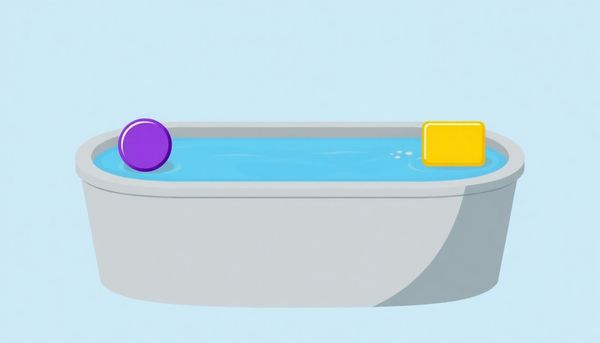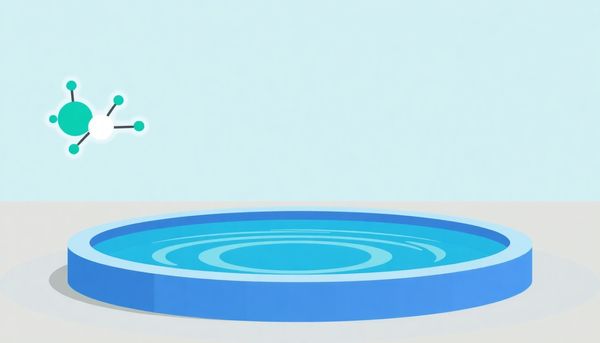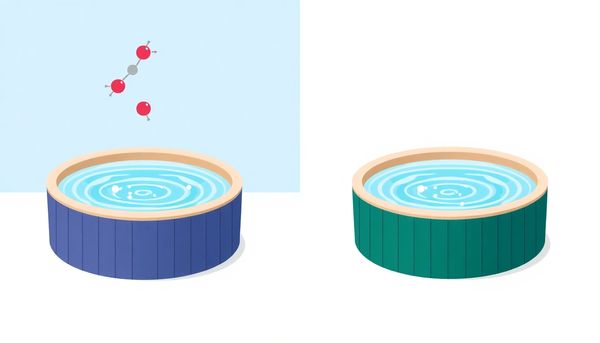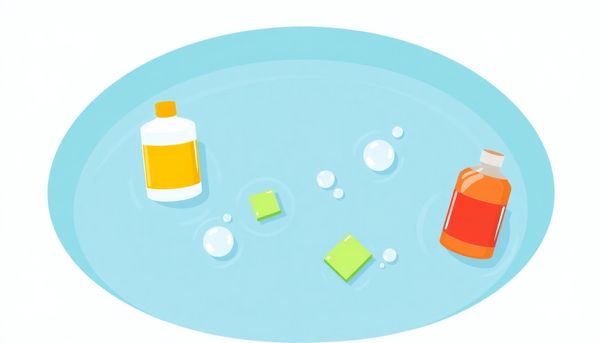Hot Tub Sanitizers: Bromine vs. Chlorine - A Comprehensive Guide
August 30th, 2024
August 30th, 2024
Choosing the ideal sanitizer for your hot tub can feel like navigating a maze of options, each promising crystal-clear water and a safe bathing experience. Among the top contenders in this watery realm are bromine and chlorine, two chemical giants with distinct characteristics. Both have carved out their niches in the world of pool and spa maintenance, yet they serve your hot tub in slightly different ways.
Growing up, my family had a hot tub tucked away in our backyard, a haven of warmth during chilly evenings. The constant debate between my parents about whether to use bromine or chlorine was a regular dinner table topic. Bromine was hailed for its ability to work effectively across a broader range of pH levels and its gentler touch on sensitive skin. Chlorine, meanwhile, boasted a powerful punch against bacteria and faster oxidation rates, making it a popular choice for many.
Understanding the nuances of these sanitizers is crucial. It's not just about their chemical compositions but how they react to various factors like water temperature, usage frequency, and personal preferences. For those with allergies or sensitive skin, bromine might be the gentler option. On the other hand, chlorine's rapid action may appeal to those looking for a quick, efficient solution. Both have their merits, and choosing the right one can transform your hot tub experience into one of comfort and safety.

In the world of hot tub sanitizers, the often-underestimated bromine quietly showcases a range of benefits that might make it the star of your spa experience. For those who enjoy a soak indoors, bromine emerges as a gentle giant, devoid of the harsh chemical smell that chlorine is notorious for. Imagine stepping into a relaxing hot tub without the sting of chlorine's odor assaulting your senses. This alone can transform your hot tub ritual into a more pleasant retreat.
Bromine is not just about a milder scent; it boasts a consistent performance in warm water, making it particularly effective for hot tubs where temperatures soar. Even after it bonds with contaminants, bromine remains active longer than chlorine, continuing its sanitizing mission. This means less frequent top-ups and a more stable sanitizing process, saving both time and effort.
For people with sensitive skin or respiratory concerns, bromine’s gentle nature can be a blessing. It’s less likely to cause irritation, allowing everyone to enjoy the hot tub without the worry of adverse reactions. Additionally, bromine's lower pH level means your hot tub water remains more balanced, reducing the need for chemical adjustments.
In essence, bromine’s quiet efficiency and user-friendly nature make it an attractive choice for those who prioritize comfort and convenience in their hot tub maintenance routine. Whether you're seeking a peaceful soak without the chemical chaos or a reliable and consistent sanitizer, bromine brings a host of benefits to the table.
When thinking about indoor hot tubs, bromine often emerges as the unsung hero in the world of sanitizers. Picture yourself relaxing in your indoor oasis without the overpowering chemical scent that chlorine is notorious for. Bromine offers a subtler approach to water care, making it ideal for enclosed spaces where proper ventilation can sometimes pose a challenge. Unlike chlorine, which can assault your senses, bromine does its job quietly, maintaining water quality while keeping the air fresh.
In my own experience, switching to bromine for our family’s indoor hot tub was a game-changer. Visitors would often comment on the absence of that typical pool smell, and it was a relief for those with sensitive skin. Bromine’s low pH level also played a crucial role in balancing the water chemistry. This meant fewer adjustments and less time worrying about the state of our hot tub, translating to more moments spent enjoying its soothing embrace.
Furthermore, bromine’s stability in warm water is a compelling reason to choose it, especially when heat exposure is constant in indoor settings. Despite requiring a larger initial dose compared to chlorine, bromine’s longevity often balances out the cost-effectiveness over time. For those who value a serene, odor-free hot tub experience within the comfort of their homes, bromine undoubtedly stands as the superior choice.
When pondering the ideal sanitizer for your hot tub, bromine emerges as a compelling candidate, especially when it comes to maintaining water stability. Unlike chlorine, bromine excels in environments with higher temperatures, making it a standout choice for hot tubs. This characteristic stems from bromine’s ability to remain active even after neutralizing contaminants, due to its unique reaction process known as ionization. While chlorine dissipates rapidly and forms chloramines, bromine's waste product, bromamines, are significantly less irritating and maintain sanitizer effectiveness longer.
Consider those cozy evenings when the hot tub beckons with its inviting warmth. You want the water to be pristine without the overwhelming scent associated with chlorine. Bromine not only addresses this concern but also helps in keeping the pH levels more balanced due to its lower pH compared to chlorine. This means fewer chemical adjustments, allowing you more time to enjoy the relaxing bubbles without frequent water testing interruptions.
For those who frequently use their indoor hot tubs or have sensitive skin, bromine offers a gentler alternative. Its slow-dissolving tablets work effectively in brominators or floating dispensers, providing a consistent and long-lasting defense against contaminants. While bromine may require a larger initial dose and be somewhat pricier, its stability in warm water environments ensures that your hot tub experience remains consistently enjoyable and hassle-free.
When stepping into the world of hot tub maintenance, the subtle nuances between sanitizers can make a significant difference, particularly in terms of odor. Bromine stands out as a remarkable ally for those sensitive to strong chemical smells. Unlike chlorine, which often leaves a pungent reminder lingering in the air, bromine operates with a lesser olfactory footprint. This feature is particularly beneficial for hot tubs nestled indoors, where ventilation may not be as robust as in outdoor settings.
Consider a friend who recently switched from chlorine to bromine due to constant complaints from family members about the overpowering chlorine smell. Overnight, their cozy indoor spa transformed from a chemical-scented chamber to a serene retreat. While bromine might require a bit more investment upfront, the long-term comfort it provides, especially in terms of air quality, is often worth the cost.
Moreover, bromine's low pH also aids in maintaining a balanced water chemistry, another advantage for those looking to minimize the fuss associated with regular water adjustments. As you weigh your options, remember that a hot tub is not just a water-filled basin; it’s a personal sanctuary. Choosing bromine might just enhance that sanctuary, ensuring your relaxation is accompanied by subtle scents rather than harsh chemicals.

When it comes to chlorine’s efficiency as a hot tub sanitizer, the spotlight shines brightly on its swift action. Chlorine is renowned for its rapid reactivity, quickly annihilating bacteria and other waterborne intruders. This speed is particularly advantageous for those who use their hot tub frequently and want to ensure the water is always ready for use with minimal waiting time. Personally, having experienced the convenience of this quick disinfection, it’s a lifesaver during impromptu hot tub parties with friends.
Chlorine's effectiveness, however, requires consistent maintenance. This sanitizer is notorious for forming chloramines, the byproducts that emerge when chlorine binds with contaminants. These chloramines are responsible for the pungent odor often associated with pools and can irritate skin and eyes. To combat this, regular dosing and occasional shocking are necessary to maintain optimal water clarity and safety. In my own experience, setting a weekly reminder to check and adjust chlorine levels has proven indispensable for keeping water crystal clear and inviting.
One must also consider the impact of UV light, especially for outdoor hot tubs. Sunlight can break down chlorine more quickly than bromine, necessitating a vigilant approach to monitoring levels. Yet, despite these challenges, chlorine’s affordability and accessibility make it a go-to choice for many hot tub owners. It is essential to balance its strengths with diligent care to keep your hot tub not just clean, but a true oasis of relaxation.
When pondering the chemical stability of sanitizers for your hot tub, it's crucial to understand the environmental conditions each faces. Bromine and chlorine, both members of the halogen family, differ vastly in their reactions to temperature and sunlight. Bromine holds a clear edge when it comes to stability in the warm, cozy waters of a hot tub. It's designed to withstand high temperatures without losing its effectiveness, which is why it's often recommended for indoor hot tubs or those constantly heated.
On the other hand, chlorine, though a speedster in germ-killing, struggles with stability in warm water. Its rapid reactivity means it can dissipate quickly in heated environments, necessitating frequent replenishment. This might keep your hot tub in pristine condition, but could lead to increased maintenance efforts.
Outdoor hot tubs present a different challenge altogether. Here, UV light plays a significant role in weakening bromine's stability, breaking it down faster than it does chlorine. This makes chlorine a more viable choice for open-air settings, especially when paired with a sturdy hot tub cover to shield it from the sun.
I remember chatting with a friend whose outdoor tub was constantly fluctuating in water quality. Switching to chlorine and diligently using a cover made all the difference for her. Such decisions boil down to understanding the specific needs of your hot tub's environment. Whether indoors or out, each sanitizer offers unique benefits that can align with your lifestyle and setup.
When weighing the cost-effectiveness of bromine versus chlorine as hot tub sanitizers, it’s crucial to look beyond the initial price tags. Chlorine often catches the eye with its lower upfront cost compared to bromine. Its widespread availability and easy application make it appealing for those new to hot tub maintenance. However, the story doesn’t end there. Regular usage can quickly add up in maintenance costs, as chlorine needs frequent additions—sometimes even weekly—to combat the build-up of chloramines, which are notorious for their pungent smell and irritation.
On the other hand, bromine, while initially pricier, offers a more stable alternative. It’s particularly advantageous in hot tub settings where water temperatures are consistently high. Bromine’s slow-dissolving properties mean it requires less frequent dosing, potentially balancing out its higher cost over time. Additionally, bromine tablets can be more forgiving on sensitive skin, which could save on any additional products needed to soothe chlorine-induced irritation.
One personal note: if you’re someone who uses their hot tub frequently, or perhaps shares it with family or friends, the reduced hassle of less frequent maintenance with bromine might be worth its weight in gold. Ultimately, the decision hinges on balancing the initial cost with ongoing maintenance needs, personal comfort, and usage patterns. In essence, investing a bit more upfront in bromine might just save you time and money in the long run.
Choosing the right sanitizer for your hot tub involves more than just considering cost and convenience; it also requires assessing how your tub's location—indoor or outdoor—affects the sanitizer's performance. Sanitizers behave differently depending on environmental factors, and understanding these can guide you to a more informed decision.
For indoor hot tubs, bromine often steals the spotlight. Unlike chlorine, which can bombard you with its signature sharp scent, bromine offers a more subtle olfactory presence. This makes it particularly suitable for enclosed spaces where ventilation might be limited. Moreover, bromine is more stable in the consistently warm water typical of hot tubs, maintaining its effectiveness over a longer period without frequent reapplication.
In contrast, outdoor hot tubs present their own set of challenges. The sun’s ultraviolet rays can rapidly break down bromine, making it less efficient. Here, chlorine tends to perform better, its resilience to UV exposure lending it a longer-lasting sanitizing capability under the open sky. While more frequent additions may be necessary to combat chloramine build-up, chlorine's quick action ensures that your tub remains inviting and safe for use.
Ultimately, your choice between bromine and chlorine should take into account not only the sanitizer’s characteristics but also the specific conditions of your hot tub’s location. By aligning your sanitizer choice with your hot tub's environment, you create a more harmonious and effective maintenance routine.

Understanding the alchemy of water chemistry is crucial to maximizing the effectiveness of your hot tub sanitizer, whether you lean towards bromine or chlorine. With each dip, the balance of pH and sanitizer levels in your hot tub can waver, like a tightrope walker teetering above a bustling crowd. Keeping everything in harmony is not just about adding chemicals; it’s about maintaining an environment where your sanitizer can work efficiently.
Consider the subtle dance that bromine performs in your hot tub. With its lower pH, bromine naturally stabilizes your water chemistry, reducing the frequency of adjustments. This means less hassle for you and more time soaking stress away. On the other hand, chlorine, though a bit more volatile in hot temperatures, acts with speed and precision. However, it requires consistent checks to ensure it doesn’t spiral into the realm of chloramine dominance, which can lead to that notorious chlorine odor.
Regular testing is your best ally here. Kits or test strips will reveal not only the sanitizer levels but also pH, total alkalinity, and other critical factors. For instance, a friend of mine was initially frustrated by frequent skin irritations until they realized their pH was too low, empowering their chlorine to irritate rather than sanitize. By tweaking and balancing, they transformed their hot tub into a personal oasis of comfort, free from harsh side effects. Remember, maintaining equilibrium in your water chemistry isn't just a task—it's an art form that rewards you with sparkling, inviting waters.
When the time comes to decide on the right sanitizer for your hot tub, the choice between bromine and chlorine hinges on several factors beyond mere cost and convenience. Let’s explore the nuances to help you make an informed decision that suits your lifestyle and hot tub environment.
Chlorine, the classic choice for sanitizing swimming pools, is celebrated for its fast-acting properties. It's an ideal option for outdoor hot tubs due to its resilience against ultraviolet (UV) light from the sun. However, chlorine's notorious odor and potential to cause skin irritation can be off-putting, especially if your hot tub is indoors or frequented by those with sensitive skin. A friend of mine swore by chlorine for years until her family started experiencing itchy skin after each soak. Switching sanitizers transformed their hot tub experience overnight.
Bromine, on the other hand, is like the reliable sibling that quietly does its job without a fuss. It works steadily, even in warm water, making it a strong contender for indoor hot tubs. Its low odor profile and less irritating nature make it a favorite among those with respiratory sensitivities. Moreover, bromine’s stability means fewer fluctuations in water chemistry, allowing for less frequent maintenance. However, it does come with a heftier price tag and requires higher doses to achieve similar effectiveness to chlorine.
Ultimately, your choice should consider not just the immediate costs but also the long-term comfort and maintenance requirements. Whether you prefer the rapid action of chlorine or the gentle persistence of bromine, ensuring your hot tub remains a sanctuary of relaxation and health is what truly counts.
Understanding when and how to use chlorine and bromine in your hot tub can transform your water care routine from a chore into a seamless experience. Imagine sitting by your hot tub with a cup of coffee, looking at the clear, inviting water and knowing it’s safe and clean. That’s the magic of mastering these sanitizers.
Chlorine has long been the go-to choice for pool owners due to its efficiency and affordability. It's a bit like having a reliable old friend—always there to get the job done, even if they bring along a bit of a smell. Chlorine works rapidly, making it ideal for those who need quick action. Yet, it requires regular attention, with a need to top it up frequently to battle chloramines, its byproduct, which can irritate the skin and eyes.
On the other hand, bromine takes the prize for stability, especially in the warm, cozy environment of a hot tub. Though a tad pricier, its slower dissipation means less frequent dosing. Bromine’s byproducts, bromamines, are gentler, reducing the risk of irritation. Plus, its low pH helps maintain balanced water chemistry, cutting down on additional chemical adjustments.
Whether opting for the fast-acting prowess of chlorine or the steady reliability of bromine, understanding these nuances helps craft a hot tub haven that’s tailored to your lifestyle and needs.
Choosing the right sanitizer is just the first step; keeping your hot tub water sparkling and safe requires regular maintenance. Start by familiarizing yourself with the basics of water chemistry. A small investment in water testing strips or a digital tester can save you from future headaches. These tools gauge pH levels, alkalinity, and sanitizer concentration, ensuring they remain within the recommended range.
When using chlorine, remember that it's quite reactive and tends to dissipate quickly, especially in sunlight. For outdoor tubs, a sturdy cover is your ally against UV degradation. Regularly shocking the water to break down chloramines will also keep that unmistakable bleach scent at bay. Bromine, on the other hand, thrives in the warm environment of indoor hot tubs, maintaining stability even in high temperatures. Despite its higher cost, bromine's slow dissolution rate might balance out expenses over time.
Consider adding a mineral purifier to complement bromine or chlorine. This can further reduce the reliance on chemical sanitizers, making your maintenance routine more eco-friendly and potentially less irritating to sensitive skin. With time, you’ll develop a rhythm—checking levels weekly, adjusting dosages as needed, and enjoying a consistently clean spa experience. Establish a maintenance schedule, and soon enough, clear, inviting water will become the norm rather than the exception.
Choosing the right sanitizer for your hot tub feels a bit like selecting a trusty pair of shoes—comfort, durability, and occasion matter. Bromine and chlorine, while both hailing from the same chemical family, offer distinct experiences. Consider bromine your go-to for indoor hot tubs. Its subtle aroma won’t overpower your senses, a boon for those who enjoy hot tubbing indoors without the lingering smell of a public pool.
One may find bromine's stability in high temperatures particularly appealing. Its chemical structure allows it to maintain effectiveness longer than chlorine, especially when your tub is bubbling away at higher temps. However, bromine does have its Achilles’ heel: UV light. If your hot tub sits outside, chlorine might edge ahead, surviving the sun’s rays more robustly.
Chlorine, the more familiar contender, is often praised for its swift action against contaminants. It's not only budget-friendly but also readily available. But beware—the notorious chloramines, byproducts of chlorine, might leave your skin feeling dry and your nose wrinkling at their smell.
Personal preference can also tip the scales. If sensitive skin or respiratory concerns are in play, the gentler nature of bromine might win over your heart. Whichever you choose, a consistent maintenance schedule and quality testing can transform any soak into a sublime experience. Balancing costs and comfort, let your hot tub adventures guide you to the perfect match.
Choosing between chlorine and bromine as your hot tub sanitizer can feel a bit like deciding between two similar yet distinct family members. Both come from the same halogen family and serve the crucial role of keeping your hot tub free of bacteria and contaminants. However, they go about this in different ways, each with its unique advantages tailored to specific needs.
Chlorine is often the go-to choice for outdoor hot tubs due to its rapid reactivity. It works quickly, oxidizing contaminants, but this speed comes with a few quirks. Chlorine can release an unmistakable odor, especially when it forms chloramines—byproducts that not only smell but can irritate skin and eyes if not managed correctly. Regular maintenance is key, with periodic shocking recommended to maintain clarity and cleanliness.
On the other hand, bromine is a favorite for indoor settings, prized for its stability in warm water and less pungent scent. Unlike chlorine, bromine ionizes contaminants, keeping a portion of its sanitizing power active even after initial use. Although it is more costly and requires a larger initial dose, it tends to remain effective over time, potentially balancing out the cost. Furthermore, bromine's lower pH level can help in maintaining overall water chemistry, reducing the frequency of adjustments.
Ultimately, your choice might hinge on personal sensitivities and the location of your hot tub. For those with sensitive skin or respiratory issues, bromine may offer a gentler experience. However, if your hot tub basks in the sun, chlorine might be the resilient choice. Each has its place, ensuring your hot tub remains a sanctuary of relaxation and hygiene.
Selecting the right sanitizer for your hot tub is akin to choosing the perfect pair of shoes for a long hike—comfort and effectiveness are key. Bromine and chlorine each bring unique attributes to the table, impacting how you enjoy your soak. If you've ever been put off by the sharp, lingering scent of chlorine, bromine might be your saving grace. It's gentle on the senses and, despite its higher price point, offers stability in warmer temperatures, reducing the frequency of reapplication. Think of it as the steady, reliable option, especially if your hot tub is indoors or frequently used by those with sensitive skin.
Chlorine, however, is no underdog. It acts swiftly, eliminating bacteria with speed, making it an ideal choice for those who prefer a quick maintenance routine. If budget is a significant factor, chlorine’s lower cost and ease of use can be quite appealing. Outdoor hot tubs might benefit from chlorine’s resilience under direct sunlight, as UV rays tend to degrade bromine more rapidly.
Ultimately, the decision boils down to your specific needs. For frequent hot tubbers who prioritize a low-maintenance, less irritating option, bromine could be the right choice. Conversely, if you favor a cost-effective, fast-acting solution and your tub is outdoors, chlorine may be the winner. Each sanitizer has its strengths; it's about matching those to your lifestyle and preferences.
When considering which sanitizer to employ for your hot tub, understanding how effectively they combat bacteria is crucial. Chlorine and bromine, while both hailing from the same halogen family, each have unique strengths and potential drawbacks. During a summer holiday, I once experienced the sharp scent of chlorine at a friend’s pool and found myself pondering why anyone would choose it for an indoor hot tub. The reality is, chlorine's fast-acting nature makes it a powerhouse for swiftly dealing with contaminants. Yet, this efficiency comes at a cost—a lingering odor and the potential for skin irritation.
Bromine, on the other hand, is like the silent guardian of clean water. The absence of a strong smell is one of its defining benefits, making it an excellent choice for indoor settings. Its chemical stability, particularly in hot water, ensures it stays active longer, reducing the frequency of maintenance. However, it’s not without its flaws. Over time, bromamines can develop, subtly decreasing its efficacy. Regular shocking can mitigate this drawback, much like its chlorine counterpart.
Both sanitizers require careful balancing acts involving water testing and adjustments. Bromine might initially cost more, but its longevity can potentially even out expenditures in the long run. Ultimately, your choice hinges on personal tolerance and where your hot tub is located—indoors or under the open sky. With this knowledge, choosing the right sanitizer becomes less a chore and more a path to enjoying crystal-clear waters.

A hot tub is a haven of relaxation, but maintaining its cleanliness is essential to enjoy it fully. Whether you're team bromine or a chlorine enthusiast, understanding how to keep your hot tub sanitized is crucial. Bromine and chlorine each have their distinct benefits and drawbacks, but both require consistent attention to ensure your water remains inviting.
So, what's the secret to pristine water? Regular testing and balancing. A friend once told me that they used to struggle with murky water until they started checking the pH and sanitizer levels every week. It made all the difference, turning their tub into an oasis. Test strips are your best friends here, giving you a snapshot of your water's chemical composition in seconds.
Don't forget the importance of "shocking" your hot tub. This process, akin to hitting the reset button, helps break down those pesky chloramines or bromamines that can cause odors and skin irritation. Whether you opt for non-chlorine shock or traditional chlorine shock, it's a ritual that rejuvenates your water's health.
Regular maintenance isn't just about adding chemicals. Clean your filters, scrub the shell, and ensure your cover is in good condition. A cover not only keeps debris out but also protects the water from UV rays, which can degrade bromine faster than chlorine. Keep these practices in mind, and your hot tub will be ready for a soak anytime you are.
When selecting the ideal sanitizer for your hot tub, the decision often boils down to understanding your personal preferences and lifestyle needs. Bromine and chlorine each offer unique benefits and drawbacks. If you're someone who relishes a relaxing soak without the harsh smell of chemicals, bromine might be your go-to choice. Bromine's stability in warm water and its gentler effect on sensitive skin make it a favorite among indoor hot tub users. However, don't overlook the fact that it does come with a slightly higher price tag and a slower reactivity rate compared to chlorine.
For those who prioritize cost and ease of use, chlorine presents itself as an efficient and wallet-friendly option. Its ability to quickly neutralize contaminants can ensure that your hot tub stays pristine, although it requires regular dosing to avoid the formation of chloramines. Chlorine is particularly suitable for outdoor hot tubs due to its resilience against UV rays, ensuring your water remains safe and clean under the sun’s exposure.
Perhaps you’re someone who enjoys a hassle-free routine? Consider a saltwater system which utilizes a generator to convert salt into chlorine, reducing the need for manual intervention. Whichever sanitizer you choose, regular water testing is essential to maintain optimal levels, ensuring a safe and enjoyable hot tub experience. Ultimately, the choice is a balance between convenience, cost, and comfort, tailored to fit your unique needs.
Choosing between bromine and chlorine for hot tub sanitation involves more than just personal preference—it hinges on optimizing their effectiveness. The goal is simple: keeping your hot tub sparkling and safe.
First, think about your hot tub's location. Chlorine, known for its swift action, shines best in outdoor settings. Its rapid reactivity can handle the onslaught of contaminants caused by weather and frequent use. However, if your hot tub enjoys the shelter of indoor space, bromine might edge out chlorine. Its stability in warm environments ensures prolonged effectiveness, reducing the frequency of re-dosing.
Next, consider the method of application. For both sanitizers, options like tablets or granules can impact their longevity and ease of use. Tablets dissolve slowly, offering a consistent release, but require regular monitoring. Granules, on the other hand, allow precise control over dosage but need more frequent additions.
Testing the water regularly is crucial. Whether you're using chlorine or bromine, maintaining proper parts per million (ppm) levels is vital. Invest in reliable test strips to quickly measure seven key chemistries, including total chlorine, total bromine, and pH levels. By keeping these metrics in check, you can adjust as necessary, ensuring that the chosen sanitizer always performs at its best.
Finally, don’t ignore the need for periodic shocking. This process revitalizes your sanitizer’s ability to combat contaminants efficiently. By understanding your sanitizer’s strengths and weaknesses, you can make informed choices that keep your hot tub inviting and clean.

This article provided insights into maintaining your pool. Start your pool care journey today!
Want to become a pool maintenance expert? Our free Pool School course covers everything you need to know about pool care. From basic maintenance to advanced troubleshooting, you'll learn how to:
Join over 10,000 pool owners who have already transformed their pool care routine. Get started with our free Pool School course today!